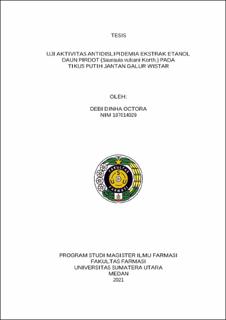| dc.description.abstract | Dyslipidemia is a lipid metabolism disorder characterized by an increase in total cholesterol levels, triglyceride levels and LDL (Low Density Lipoprotein) levels and a decrease in HDL (High Density Lipoprotein) levels. The pirdot plant (Saurauia vulcani Korth.) of the Actinidaceae family is one of the natural ingredients that is widely used by the community as an alternative medicine to treat disease. Parts of plants that are often used are the leaves. Pirdot leaves contain chemical compounds of flavonoids, tannins and saponins that have the potential to improve lipid profiles and prevent cardiovascular disease.
The purpose of this study was to determine the effect of ethanol extract of pirdot leaves (EEDP) on the lipid profile of dyslipidemic rats and increase aortic cell proliferation in dyslipidemic rats.
The study began with examination of phytochemical characterization and screening, manufacture of ethanol extract of pirdot leaf (EEDP) by maceration, induction in rats, testing of rat lipid profile and examination of rat aortic cell proliferation. The test was divided into 6 groups, namely control CMC Na 0.5%, Atorvastin and EEDP doses of 50, 100, 200, 400 mg/kg BW. The parameters observed were a decrease in lipid profile levels (KC, LDL, TG, HDL), aortic cell proliferation and a decrease in foam cells. Induction was carried out for 30 days, then lipid profile testing was carried out, followed by administration of 0.5% CMC Na, Atorvastin and EEDP doses of 50, 100, 200, 400 mg/kg BW for 21 days orally every day, on the 22nd day of rats. After surgery, blood serum was taken and the aorta was observed. Lipid profile and aortic cell proliferation data were analyzed by one-way ANOVA method followed by Tukey's post-hoc test.
The results of the study on the lipid profile of mice showed that EEDP doses of 50, 100, 200, 400 mg/kg BW can reduce lipid profile and increase HDL significantly (p<0.05) with the control group CMC Na 0.5%, EEDP dose of 400 mg/kg BW is the best dose in influencing the lipid profile. (the values of TC, TG, LDL and HDL were 163.20, 42.80, 61.40, 59.00 mg/dL) and increased proliferation of cardiac aortic cells in dyslipidemic rats was 69.84±0.27.
Based on the above results, it can be concluded that EEDP dose of 400 mg/kg BW has an effect on the lipid profile of dyslipidemic rats (reduction in total cholesterol levels, triglyceride levels, LDL levels and increased HDL levels) and can increase aortic cell proliferation. | en_US |


